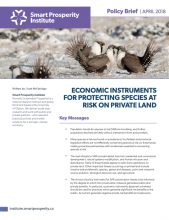April 9, 2018
89% of Canadians want to protect species at risk. However, many species at risk are found on private land --which presents a unique challenge compared to protection on public lands. Read our latest Policy Brief on how to engage private landowners in species-at-risk conservation.
Key Messages:
- Population trends for species at risk (SAR) are troubling, and further population declines are likely without intervention from policymakers.
- Many species at risk are found on private land, but federal and provincial legislative efforts are not effectively conserving species at risk on these lands, making proactive partnerships with landowners essential to recovering species at risk.
- The main threats to SAR include habitat loss from residential and commercial development, natural systems modification, and human intrusion and disturbance. Many of these threats appear to stem from operations on private land. Other important threats occurring on private land include invasive and problematic species, genes and diseases, point and nonpoint source pollution, biological resource use, and agriculture.
- The choice of policy instrument for SAR conservation needs to be informed by the degree to which the conservation measure generates public and private benefits. In particular, economic instruments (payment schemes) should be used for practices which generate significant net benefits to the public, but which generate negative private net benefits for landowners.
- Governments are still making limited use of economic instruments for SAR recovery on private land, despite stakeholder perceptions that they are effective and would enjoy high levels of public support. The historic investments in nature protection announced in Budget 2018 provide policy makers with an opportunity to change this.
- By compensating landowners for the SAR protection benefits that they are providing to society, economic instruments have a major role to play in fostering cost-effective SAR recovery on private land. For instance, studies of reverse auctions have found that they can lead to substantial cost savings relative to fixed payment schemes – ranging from 16 to 315 per cent. Expanding on these economic instruments and fine-tuning them has real potential to improve SAR recovery outcomes.
- We outline some preliminary lessons learned from two economic instruments and two incentive programs which contribute to SAR recovery on private land: conservation easements and payment for ecological service schemes, as well as the Ecological Gifts Program and the Natural Areas Conservation Program. We also provide some suggestions on how these tools and programs could be strengthened to scale up and enhance SAR recovery.
- The federal government should consider establishing mechanisms through which landowners adopting economic instruments for SAR conservation could easily ‘opt in’ to conservation agreements under section 11 of Canada’s Species at Risk Act.
- Key barriers to using economic instruments for species at risk conservation on private land include transaction and monitoring costs, landowners’ perceptions of the conservation program, and concerns that economic incentives might ‘crowd out’ voluntary conservation actions. However, these barriers need to be understood in context and viable solutions exist for each of them.
- Implications for policy makers include designing explicitly targeted incentive programs, balancing trade-offs between targeted, stringent programs and their transaction costs to ensure a critical mass of participation, and the need to implement economic instruments as field experiments or quasi-experiments, to ensure the best value for money.




